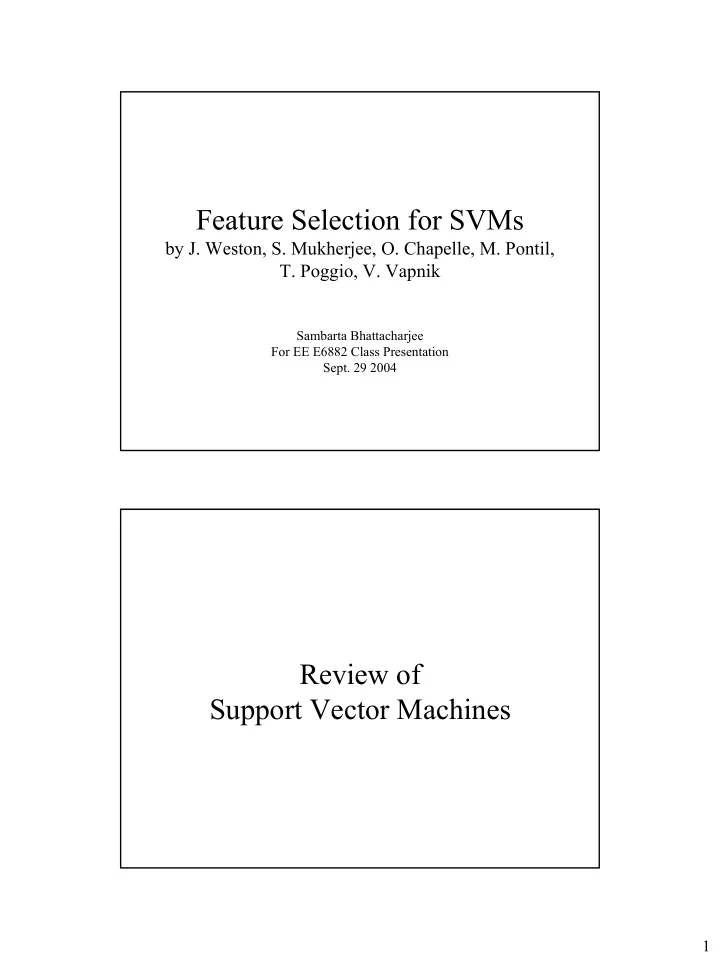

Feature Selection for SVMs by J. Weston, S. Mukherjee, O. Chapelle, M. Pontil, T. Poggio, V. Vapnik Sambarta Bhattacharjee For EE E6882 Class Presentation Sept. 29 2004 Review of Support Vector Machines 1
A support vector machine classifies data as +1 or -1 • A decision boundary with maximum margin looks like it should generalize well Support Vector Machines 2
• Minimize True Risk ? • Miminize Guaranteed Risk instead • A decision boundary with • VC dimension h = # of training points that maximum margin looks can be shattered – eg. h=3 for 2-D linear classifier like it should generalize well • To minimize J, minimize h • To minimize h, maximize margin M • Structural Risk Minimization: minimize R emp while maximizing margin Support Vector Machines Support Vector Machines Support Vector Machines • Maximize margin subject to classifying all points correctly • . The support vector machine • To classify: 3
Support Vector Machines • Support Vectors: Support Vector Machines • Dual Problem 4
Support Vector Machines • Dual Problem • Nonseparable? Support Vector Machines • Dual Problem • Nonseparable? • Nonlinear? Cover’s theorem on the separability of patterns: A pattern classification problem cast in a high-dimensional space is more likely to be linearly separable 5
SVM Matlab Implementation %To train.. for i=1:N for j=1:N Another parameter in the qp program H(i,j)=Y(i)*Y(j)*svm_kernel(ker,X(i,:),X(j,:)); sets this constraint to an equality end end alpha=qp(H,f,A,b,vlb,vub); %X=QP(H,f,A,b) solves the quadratic programming problem: % min 0.5*x'Hx + f'x subject to: Ax <= b % x %X=QP(H,f,A,b,VLB,VUB) defines a set of lower and upper bounds on the %design variables, X, so the soln is always in the range VLB <= X <= VUB. SVM Matlab Implementation %To classify.. for i=1:M The bias term is found from the KKT for j=1:N conditions H(i,j)=Ytrn(j)*svm_kernel(ker,Xtst(i,:),Xtrn(j,:)); end end Ytst=sign(H*alpha+b0); 6
Support Vector Machines • Summary – Use Matlab’s qp( ) to perform optimization on training points and get parameters of hyperplane – Use hyperplane to classify test points Feature Selection for SVMs 7
Here's some data Row 20 is a 11-D data point 60 data points The data is classified as +1 (black) or -1 (white) Col 3 is the 3rd dimension Dimension 6 is pretty useless in classification 8
We want to find the relative discriminative ability of each dimension, and throw away the least discriminative dimensions Dimensionality Reduction • Improve generalization error • Need less training data (avoid curse of dimensionality) • Speed, computational cost • (qualitative) Find out which features matter • For SVMs, irrelevant features hurt performance 9
Formal problem input weights loss functional • Weight each feature by 0 or 1 • Which set of weights minimizes (average expected) loss? – Specifically, if we want to keep m features out of n, which set of weights minimizes loss subject to the constraint that weight vector sums to m? • We don't know P(x,y) 10
Formal solution (approximations) • Weight each feature by 0 or 1 11
~ = • Weight each feature by 0 or 1 • Weight each feature by a real valued vector • First approach suggests combinatorial search over all weights (intractable for large dimensionality) • Second approach brings you closer to a gradient descent solution • There’s a weight vector that minimizes (average expected) loss • There’s a weight vector that minimizes expected leave-one-out error probability for weighted inputs 12
~ = • There’s a weight vector that minimizes (average expected) loss • There’s a weight vector that minimizes expected leave-one-out error probability for weighted inputs • Let's pretend these are the same ("wrapper method") • Theorem • Data in sphere of size R, separable with margin M (1/M 2 =W 2 ) 13
~ = • Theorem • Data in sphere of size R, separable with margin M (1/M 2 =W 2 ) • To minimize error probability, let’s minimize R 2 W 2 instead • Someone gives us a contour map, telling us which direction to walk in weight vector space to get highest increase in R 2 W 2 • We take a small step in the opposite direction • Check map again • Repeat above steps (until we stop moving) This is gradient descent 14
another SVM training optimization problem This is the contour map Feature Selection for SVMs • Choose kernel, find gradient, proceed with above algorithm to find weights • Throw away lowest weighted dimension(s) after gradient descent finds minimum, repeat until you have specified number of dimensions left – E.g. You have 123 dimensions (41 average X Y Z coordinates of person’s joints) for walking/running classification. You want to reduce to 6 (maybe these will be the X Y Z coordinates of both ankles) – Throw away worst 2 dimensions after each run of algorithm until you have desired number left 15
Feature Selection for SVMs – Throw away worst q dimensions after each run of algorithm until you have desired number left – As we increase q, fewer calls to qp algorithm and faster performance For this data 16
We get this weighting Dimension 6 is the first to go For this data dimension 1 +1 data dimension points 112*92= 10304 (images unrolled into one long vector) -1 data points 17
We get this weighting hairline is discriminatory So is head position And… • Automatic dimensionality reduction? (user doesn’t have to specify number of dimensions) 18
References • [1] J. Weston, S. Mukherjee, O. Chapelle, M. Pontil, T. Poggio, V. Vapnik, Feature selection for SVMs. Advances in Neural Information Processing Systems 13. MIT Press, 2001 • [2] O. Chapelle, V. Vapnik, Choosing Multiple Parameters for Support Vector Machines. Machine Learning, 2001 • [3] S. Haykin, Neural Networks: A Comprehensive Foundation. Prentice-Hall, Inc. 1999 • [4] V. Vapnik, Statistical Learning Theory, John Wiley, 1998 • [5] O. Chapelle, V. Vapnik, O. Bousquet, S. Mukherjee, Choosing Kernel Parameters for Support Vector Machines. Machine Learning, 2000 19
Recommend
More recommend